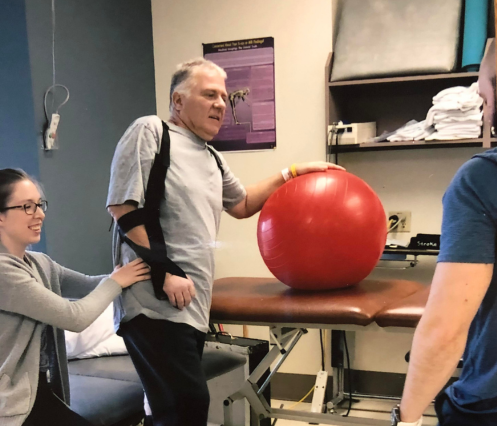Life After Stroke: the story of one VON client

After surviving two strokes, VON client Chris was determined to return to the activities he previously enjoyed.
Chris suffered from right-side paralysis and aphasia (the loss or decrease of ability to verbally communicate). As a provider of the Life After Stroke program in Strathroy, Ontario, VON worked with Chris to help him achieve his goals.
“Prior to his stroke he was a busy family man and a farmer,” says Sandra Brown, a VON recreation therapist in Middlesex-Elgin. “He was not willing to give that up. He worked extra hard and regained his ability to walk with limitations. He also worked on many aphasia therapy activities throughout his treatment.”
Following a stroke, most people require a period of rehabilitation that may include both in-hospital and in-home care. Through the Community Stroke Rehabilitation Team, they may then be referred to an in-community stroke program like Life After Stroke, offered at VON Strathroy as a specialized program within the greater Adult Day Program.
In September of 2019, Chris started attending the Life After Stroke program at the VON site in Strathroy. “Post-stroke, this was a time he really felt a great sense of belonging and an increase in motivation to continue pushing forward with his recovery,” says Sandra. “The humour, the staff and having peer support increased Chris’s self-esteem and comfort in the environment.”
Sandra says that people who have experienced a stroke are at higher risk of depression. “When we feed into that positive quality of life emotionally, the physical aspects also begin to improve,” she says. “Within a month of attending the program, a lot of our clients will reach their goal of starting to walk without a walker again. I am honoured to see the continual benefits that our program provides to our clients and their caregivers.”
As a recreation therapist, Sandra plans activities with four key domains of well-being in mind: social, emotional, physical and cognitive. Oftentimes clients don’t know they are “exercising” or being asked to work towards a goal. Sandra might ask a client to help with a task and provide the resources to modify it so it is failure free for the client or have them come with her to the freezer to grab some items for lunch and have a chat.
“Underneath that, we are achieving exercise goals and increasing self-esteem,” she explains. “This reduces further physical decline and the need for medical models of intervention while utilizing the Leisure Ability Model set out by Therapeutic Recreation Ontario. And they start to be able to do the things they enjoy again.”
Chris excelled at his goals and continues to gain and maintain mobility and a positive outlook on life. He has also worked on voice recovery through singing, and his ability to verbally communicate is slowly but surely improving. He has been amazed by the staff’s ability to understand his non-verbal communication and grateful to be involved in conversations and to share his stories.
Referrals to Life After Stroke can be made through the Community Stroke Rehabilitation Team.
February is Recreation Therapy Month, and we are happy to shine a light on the invaluable work done each and every day by our skilled recreation therapists. They work to enable those with physical and cognitive limitations to function more independently, and in this way they truly makes lives better.


